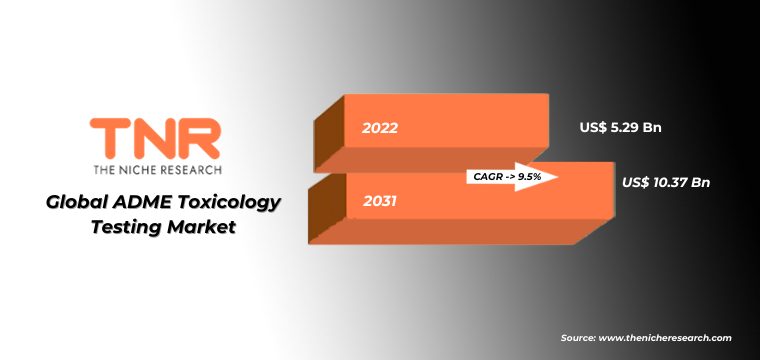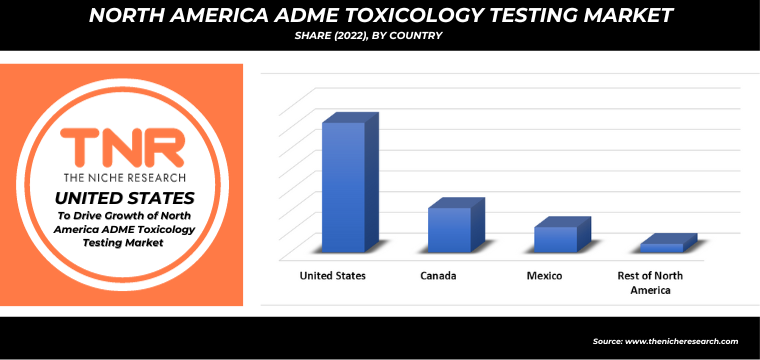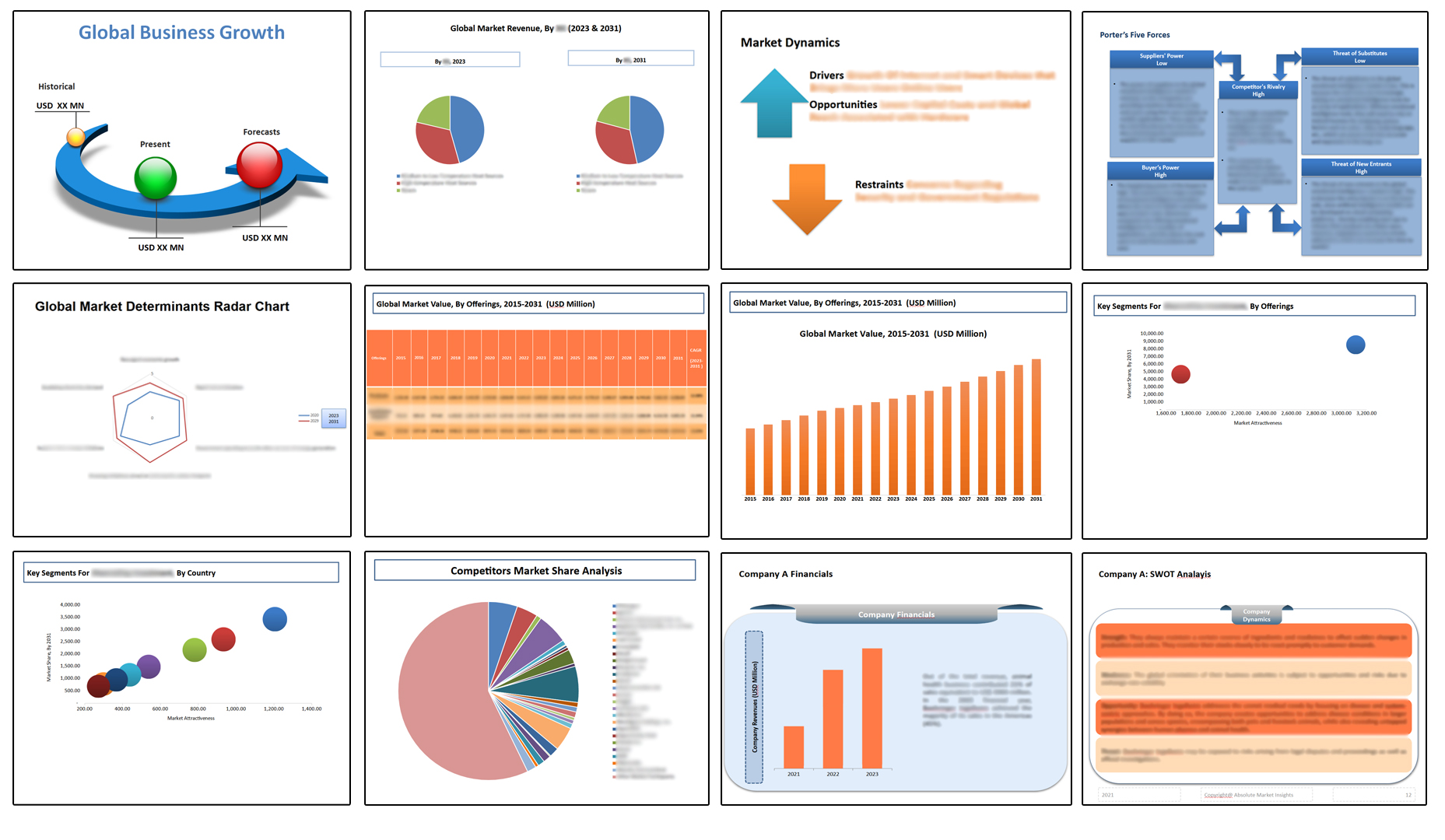Global ADME Toxicology Testing Market, By Technology, By Application, By Method, By Region & Segmental Insights Trends and Forecast, 2023 – 2031
- Industry: Healthcare
- Report ID: TNR-110-1001
- Number of Pages: 420
- Table/Charts : Yes
- November, 2023
- Base Year : 2024
- No. of Companies : 9+
- No. of Countries : 29
- Views : 10180
- Covid Impact Covered: Yes
- War Impact Covered: Yes
- Formats : PDF, Excel, PPT
Global ADME Toxicology Testing Market, By Technology, By Application, By Method, By Region & Segmental Insights Trends and Forecast, 2023 – 2031
ADME Toxicology Testing assesses how drugs or chemicals are absorbed, distributed, metabolized, and excreted (ADME) in the body, along with their potential toxicity. It helps predict a substance’s safety and effectiveness by studying its pharmacokinetics and potential adverse effects, aiding drug development and regulatory approval processes. In terms of revenue, the global ADME toxicology testing market was worth US$ 8.48 Bn in 2022, anticipated to witness CAGR of 10.5% during 2023 – 2031.
Trends in the Global ADME Toxicology Testing Market
- Presently, the ADME toxicology testing market is witnessing a surge in demand due to the continuous expansion of drug development efforts worldwide. Pharmaceutical companies are actively developing new drugs to combat emerging health challenges, including the ongoing global pandemic. This trend is driving the need for robust ADME toxicology testing to assess a drug candidate’s safety and efficacy profile comprehensively. As the pharmaceutical pipeline continues to grow, the current trend emphasizes the crucial role of ADME toxicology testing in accelerating the drug development process and ensuring the safety of potential medications.
- Another prominent driver in the ADME toxicology testing market is the increasing regulatory stringency governing drug safety assessments. Regulatory authorities like the FDA are continually updating guidelines and requirements for drug approval, mandating more extensive ADME toxicology testing. This trend is characterized by the heightened scrutiny of pharmacokinetics and toxicological assessments during drug development. As regulatory standards evolve and become more stringent, the current trend underscores the necessity for advanced and reliable ADME toxicology testing methods to meet these regulatory demands and ensure compliance in the pharmaceutical industry.
Global ADME Toxicology Testing Market Revenue & Forecast, (US$ Million), 2015 – 2031

High throughput technology segment has gained popularity in recent years and is anticipated to be the fastest growing segment in the global ADME toxicology testing market during the forecast period. The growth is primarily driven by its ability to expedite drug screening processes. High Throughput methods enable the simultaneous assessment of numerous compounds, significantly reducing testing time. As of recent years, the pharmaceutical industry has seen a notable increase in drug candidates entering development pipelines, necessitating efficient screening techniques.
For example, in 2021, the U.S. FDA approved an unprecedented quantity of new drugs. The current trend underscores the increasing reliance on High Throughput ADME testing to meet the industry’s demand for quicker, cost-effective drug evaluations, expediting the pace of drug discovery and development.

Systemic toxicity application segment had the highest share in the global ADME toxicology testing market in 2022. This segment focuses on evaluating how substances affect the entire body, ensuring comprehensive toxicity assessment. In recent years, regulatory bodies have emphasized rigorous systemic toxicity testing to ensure public health and safety. For example, in the European Union, REACH regulations mandate comprehensive toxicological evaluations. This reinforces the significance of systemic toxicity testing in drug development and chemical safety assessments, making it a cornerstone of ensuring product safety, regulatory compliance, and public well-being.

Asia Pacific is expected to witness the highest growth rate in the ADME toxicology testing market during the forecast period. The region is witnessing a surge in pharmaceutical and biotechnology research and development, making it a burgeoning hub for drug discovery. In recent years, Asia Pacific’s pharmaceutical market has been expanding significantly, with countries like China and India leading the way. For instance, in 2020, China was the third-largest pharmaceutical market globally. This growth is propelling the demand for ADME toxicology testing to ensure safe and effective drug development. The current trend underscores the region’s increasing contribution to global pharmaceutical innovation and its pivotal role in advancing ADME testing technologies.
Competitor Landscape
Some of the key companies operating in the ADME toxicology testing market are
- Agilent Technologies, Inc.
- Beckman Coulter, Inc.
- Catalent, Inc
- Charles River Laboratories
- Curia Global, Inc.
- Dassault Systemes
- Eurofins Discovery
- Labcorp Drug Development
- Promega Corporation
- Thermo Fisher Scientific Inc.
- Other Industry Participants
Global ADME Toxicology Testing Market Summary
| Report Specifications | Details |
| Market Revenue in 2022 | US$ 8.48 Bn |
| Market Size Forecast by 2031 | US$ 19.78 Bn |
| Growth Rate (CAGR) | 10.5% |
| Historic Data | 2015 – 2021 |
| Base Year for Estimation | 2022 |
| Forecast Period | 2023 – 2031 |
| Report Inclusions | Market Size & Estimates, Market Dynamics, Competitive Scenario, Trends, Growth Factors, Market Determinants, Key Investment Segmentation, Product/Service/Solutions Benchmarking |
| Segments Covered | By Technology, By Application, By Method |
| Regions Covered | North America, Europe, Asia Pacific, Middle East & Africa, Latin America |
| Countries Covered | U.S., Canada, Mexico, Rest of North America, France, The UK, Spain, Germany, Italy, Nordic Countries (Denmark, Finland, Iceland, Sweden, Norway), Benelux Union (Belgium, The Netherlands, Luxembourg), Rest of Europe, China, Japan, India, New Zealand, Australia, South Korea, Southeast Asia (Indonesia, Thailand, Malaysia, Singapore, Rest of Southeast Asia), Rest of Asia Pacific, Saudi Arabia, UAE, Egypt, Kuwait, South Africa, Rest of Middle East & Africa, Brazil, Argentina, Rest of Latin America |
| Key Players | Agilent Technologies, Inc., Beckman Coulter, Inc., Catalent, Inc, Charles River Laboratories, Curia Global, Inc., Dassault Systemes, Eurofins Discovery, Labcorp Drug Development, Promega Corporation, Thermo Fisher Scientific Inc., Other Market Participants |
| Customization Scope | Customization allows for the inclusion/modification of content pertaining to geographical regions, countries, and specific market segments. |
| Pricing & Procurement Options | Explore purchase options tailored to your specific research requirements |
| Contact Details | Consult With Our Expert
Japan (Toll-Free): +81 663-386-8111 South Korea (Toll-Free): +82-808-703-126 Saudi Arabia (Toll-Free): +966 800-850-1643 United Kingdom: +44 753-710-5080 United States: +1 302-232-5106 E-mail: askanexpert@thenicheresearch.com
|
Global ADME Toxicology Testing Market
By Technology
- Cell Culture
- High Throughput
- Molecular Imaging
- OMICS Technology
By Application
- Systemic Toxicity
- Renal Toxicity
- Hepatotoxicity
- Neurotoxicity
- Other Toxicities
By Method
- Cellular Assay
- Biochemical Assay
- In-Silica
- Ex-vivo
By Region
- North America (U.S., Canada, Mexico, Rest of North America)
- Europe (France, The UK, Spain, Germany, Italy, Nordic Countries (Denmark, Finland, Iceland, Sweden, Norway), Benelux Union (Belgium, The Netherlands, Luxembourg), Rest of Europe)
- Asia Pacific (China, Japan, India, New Zealand, Australia, South Korea, Southeast Asia (Indonesia, Thailand, Malaysia, Singapore, Rest of Southeast Asia), Rest of Asia Pacific)
- Middle East & Africa (Saudi Arabia, UAE, Egypt, Kuwait, South Africa, Rest of Middle East & Africa)
- Latin America (Brazil, Argentina, Rest of Latin America)
Report Coverage & Deliverables

Table of Contents
**Exclusive for Multi-User and Enterprise User.
Global ADME Toxicology Testing Market
By Technology
By Application
By Method
By Region
**Note: The report covers cross-segmentation analysis by region further into countries
The Niche Research approach encompasses both primary and secondary research methods to provide comprehensive insights. While primary research is the cornerstone of our studies, we also incorporate secondary research sources such as company annual reports, premium industry databases, press releases, industry journals, and white papers.
Within our primary research, we actively engage with various industry stakeholders, conducting paid interviews and surveys. Our meticulous analysis extends to every market participant in major countries, allowing us to thoroughly examine their portfolios, calculate market shares, and segment revenues.
Our data collection primarily focuses on individual countries within our research scope, enabling us to estimate regional market sizes. Typically, we employ a bottom-up approach, meticulously tracking trends in different countries. We analyze growth drivers, constraints, technological innovations, and opportunities for each country, ultimately arriving at regional figures.Our process begins by examining the growth prospects of each country. Building upon these insights, we project growth and trends for the entire region. Finally, we utilize our proprietary model to refine estimations and forecasts.
Our data validation standards are integral to ensuring the reliability and accuracy of our research findings. Here’s a breakdown of our data validation processes and the stakeholders we engage with during our primary research:
- Supply Side Analysis: We initiate a supply side analysis by directly contacting market participants, through telephonic interviews and questionnaires containing both open-ended and close-ended questions. We gather information on their portfolios, segment revenues, developments, and growth strategies.
- Demand Side Analysis: To gain insights into adoption trends and consumer preferences, we reach out to target customers and users (non-vendors). This information forms a vital part of the qualitative analysis section of our reports, covering market dynamics, adoption trends, consumer behavior, spending patterns, and other related aspects.
- Consultant Insights: We tap into the expertise of our partner consultants from around the world to obtain their unique viewpoints and perspectives. Their insights contribute to a well-rounded understanding of the markets under investigation.
- In-House Validation: To ensure data accuracy and reliability, we conduct cross-validation of data points and information through our in-house team of consultants and utilize advanced data modeling tools for thorough verification.
The forecasts we provide are based on a comprehensive assessment of various factors, including:
- Market Trends and Past Performance (Last Five Years): We accurately analyze market trends and performance data from preceding five years to identify historical patterns and understand the market’s evolution.
- Historical Performance and Growth of Market Participants: We assess the historical performance and growth trajectories of key market participants. This analysis provides insights into the competitive landscape and individual company strategies.
- Market Determinants Impact Analysis (Next Eight Years): We conduct a rigorous analysis of the factors that are projected to influence the market over the next eight years. This includes assessing both internal and external determinants that can shape market dynamics.
- Drivers and Challenges for the Forecast Period:Identify the factors expected to drive market growth during the forecast period, as well as the challenges that the industry may face. This analysis aids in deriving an accurate growth rate projection.
- New Acquisitions, Collaborations, or Partnerships: We keep a close watch on any new acquisitions, collaborations, or partnerships within the industry. These developments can have a significant impact on market dynamics and competitiveness.
- Macro and Micro Factors Analysis:A thorough examination of both macro-level factors (e.g., economic trends, regulatory changes) and micro-level factors (e.g., technological advancements, consumer preferences) that may influence the market during the forecast period.
- End-User Sentiment Analysis: To understand the market from the end-user perspective, we conduct sentiment analysis. This involves assessing the sentiment, preferences, and feedback of the end-users, which can provide valuable insights into market trends.
- Perspective of Primary Participants: Insights gathered directly from primary research participants play a crucial role in shaping our forecasts. Their perspectives and experiences provide valuable qualitative data.
- Year-on-Year Growth Trend: We utilize a year-on-year growth trend based on historical market growth and expected future trends. This helps in formulating our growth projections, aligning them with the market’s historical performance.
Research process adopted by TNR involves multiple stages, including data collection, validation, quality checks, and presentation. It’s crucial that the data and information we provide add value to your existing market understanding and expertise. We have also established partnerships with business consulting, research, and survey organizations across regions and globally to collaborate on regional analysis and data validation, ensuring the highest level of accuracy and reliability in our reports.









